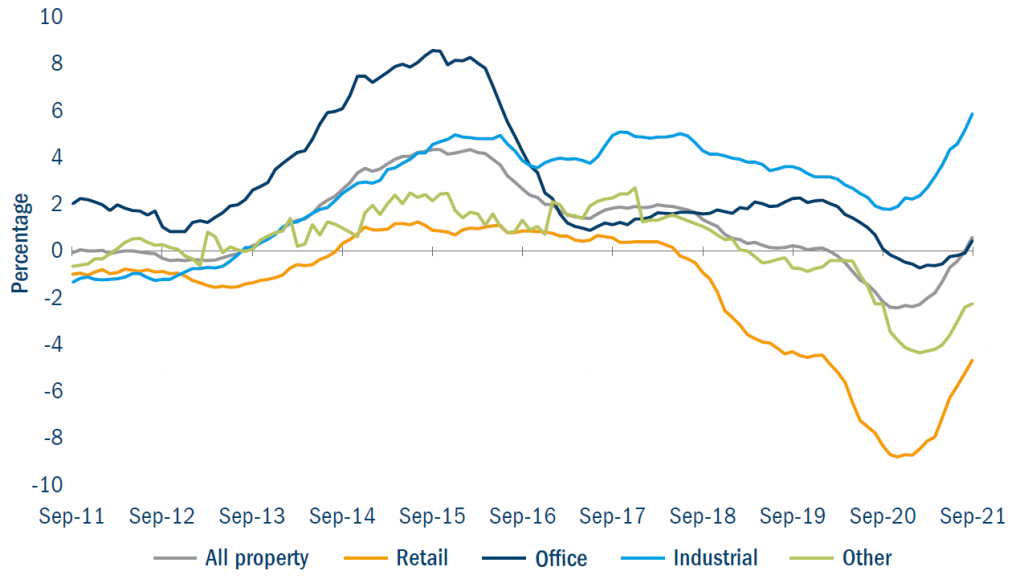2021 was a standout year for UK real estate, which delivered annualised total returns of 14.7% to the end
of October, as robust income returns were complemented by the return of capital growth. This represents the
highest level of annualised total returns since the pre-Brexit days of mid-2015. While we don’t expect 2022
to deliver the same capital value growth as 2021, it is likely to witness similar positive supply and demand
dynamics which should maintain market momentum.
If 2021 was the year of recovery, 2022 is likely to be one of
momentum. The prevailing broad-based occupational recovery
is not immune to economic headwinds (the government’s
recent move to “Plan B” is the most tangible evidence of
this, but supply-side pressures are also likely to remain as
the economy adjusts to the recovery); however, it has proved
remarkably resilient through challenging circumstances.
Occupier sentiment, with some notable exceptions, remains
positive and we are starting to see encouraging signs of business decisions which were postponed during the
pandemic begin to translate into an increase in occupier
activity. In the capital markets, investor sentiment remains
broadly positive, as evidenced by a recovery in transactional
volumes, with significant capital reportedly raised for
deployment, targeting a market expected to outperform
global strategies in the short term.1 The “All Property” Net
Initial Yield of 4.7%2 continues to offer highly attractive
relative income attributes over gilt and base rates.
Occupational dynamics differ at sector level, and portfolio managers will
have to stock pick with increasing precision to deliver outperformance.
Offices, retail and alternatives – for example, hotels and leisure – emerged
from the pandemic having been profoundly affected by shifting sentiment.
However, our experience from the front line is more positive, and we
expect these sectors to continue to recover – albeit at different speeds
and to different degrees. By way of illustration, we have been advocates of
low-rented convenience/discount-led retail warehouses for some time, as
evidenced by our deployment of significant investment in the sector in 2021.
Yields contracted sharply through the year as investor appetite for the sector
increased, however it still looks attractive as an income-led proposition.
Our high conviction view towards retail warehouses is based on
intelligence from our asset management colleagues indicating a vibrant
occupational market with tenants benefitting from reduced competition
and online resilience, and in many cases online synergies – for example,
“click and collect”. We complement this high-level conviction with forensic
asset-by-asset due diligence to ensure we invest in the right schemes in
the right locations, let to tenants known to trade well.
Industrials continue to benefit from sustained structural imbalances in
favour of landlords, which led to record levels of rental growth over the
past 12 months (6.6% to the end of October 2021, as per the MSCI UK
Property Monthly Index). Demand continues to increase as retail sales
migrate online, and other, new occupiers enter the market, for example
“dark kitchens” – shared physical premises where small businesses
can set up to provide delivery-only takeaway meals. Investor sentiment,
unsurprisingly, remains very positive towards the sector, and as a result
we have seen significant yield compression for both logistics and multilet
assets throughout the UK. Given that industrials account for more
than 40% of the index composition, this has a disproportionately positive
impact at market level.
Fig 1: 10-year UK commercial property rental value growth (annualised)

Source: MSCI UK Monthly Index, as at September 2021.
ESG (environmental, social and governance) factors will rightly continue
to influence investment decisions. Investment approaches are split
broadly between those passively buying best-in-class, and those willing
to actively manage portfolios to deliver building improvements. Prevailing
pricing is likely to reward the latter more than the former, while the middle
ground gets increasingly squeezed and at risk of stranding. We have
committed to net-zero carbon in our portfolios by at least 2050, and we
continue to implement workstreams aimed at quantifying works required
to accelerate the trajectory towards net zero, implementing refurbishment
and improvement works at a sustainable scale, and articulating the results
of those activities to our clients.
Taken together, UK real estate continues to represent attractive value on
an income basis, with modest but sustained growth potential in 2022.






